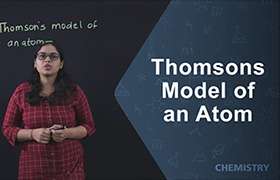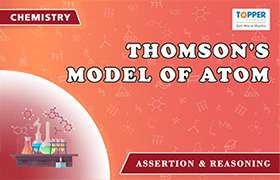CBSE Class 9 Answered
respected mam/sir,
according to neils bohr postulates, why the negatively charged electrons do not radiate or loose energy?
Asked by nimishagupta0409 | 14 Jan, 2015, 10:55: PM
- Bohr began with the assumption that electrons were orbiting the nucleus, much like the earth orbits the sun.
- From classical physics, a charge traveling in a circular path should lose energy by emitting electromagnetic radiation
- If the "orbiting" electron loses energy, it should end up spiraling into the nucleus (which it does not). Therefore, classical physical laws either don't apply or are inadequate to explain the inner workings of the atom.
- Hence, Bohr borrowed the idea of quantized energy from Planck
- He proposed that only orbits of certain radii, corresponding to defined energies, are "permitted"
- An electron orbiting in one of these "allowed" orbits:
- Has a defined energy state
- Will not radiate energy
- Will not spiral into the nucleus
- An electron which is revolving around the nucleus gets accelerated towards the nucleus. According to the electromagnetic theory, an accelerating charged particle must emit radiation, and lose energy. Because of this loss of energy, the electron would slow down, and will not be able to withstand the attraction of the nucleus. As a result, the electron should follow a spiral path, and ultimately fall into nucleus. If it happens then the atom should collapse in about 10-8 second. But this does not happen.
- As the electron approaches the tiny volume of space occupied by the nucleus, its potential energy dives down toward minus-infinity, and its kinetic energy (momentum and velocity) shoots up toward positive-infinity. This "battle of the infinities" cannot be won by either side, so a compromise is reached in which theory tells us that the fall in potential energy is just twice the kinetic energy, and the electron dances at an average distance that corresponds to the Bohr radius. Hence electron keeps revolving the nucleus without emitting or loosing energy.
Answered by Prachi Sawant | 15 Jan, 2015, 11:32: AM
Application Videos
Concept Videos
CBSE 9 - Chemistry
Asked by shivalaxmi0205 | 08 Mar, 2023, 07:47: PM
CBSE 9 - Chemistry
Asked by rekhachaturvedu422 | 01 Aug, 2022, 04:16: PM
CBSE 9 - Chemistry
Asked by senniasamy | 10 Jan, 2022, 08:48: PM
CBSE 9 - Chemistry
Asked by nathdarshana | 20 Nov, 2020, 07:03: PM
CBSE 9 - Chemistry
Asked by fathima1012006 | 31 May, 2020, 10:44: AM
CBSE 9 - Chemistry
Asked by panshulhanna18 | 29 Mar, 2020, 02:38: PM
CBSE 9 - Chemistry
Asked by wbargayary | 26 Feb, 2020, 08:39: PM
CBSE 9 - Chemistry
Asked by laldinmawia3 | 09 Oct, 2019, 07:51: PM
CBSE 9 - Chemistry
Asked by patitapabana11 | 08 Oct, 2019, 05:21: PM
CBSE 9 - Chemistry
Asked by amaryashko | 15 Sep, 2019, 05:23: PM






